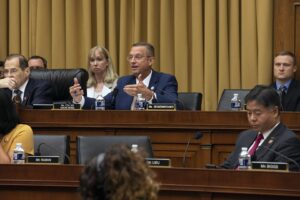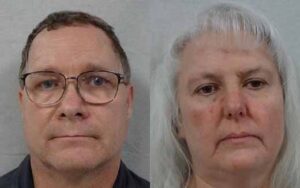
NEW ORLEANS (BP)–New Orleans artist Sherry Francalancia has been making the rounds asking local artists for their handprints on a work she is producing. The painting symbolizes this city, Sherry says. So many people have left permanent imprints on our lives for the better.
Think of that painting as a metaphor for New Orleans in its post-Katrina existence. Over the five years since that hurricane made landfall causing the poorly constructed levees to flood the city, untold thousands of God’s people have come from the ends of the earth to bless New Orleans.
A recent ad for a law firm seeking clients in a class action suit against BP began: “When Hurricane Katrina devastated our part of the world, Louisianans stood alone.”
Nothing could be further from the truth. We were inundated with friends from every direction.
Even before most of us returned from evacuation, volunteer crews arrived from churches across America to clear streets and prepare meals for first responders. Later, a second wave of church teams arrived to mud-out houses and churches and begin the rebuilding process. They bore witness to their faith in Christ and reported hundreds opening their hearts to the Lord.
That process of ministry in the name of Jesus continues today.
Duane McDaniel, executive director of missions for the New Orleans Baptist Association (formerly the Baptist Association of Greater New Orleans) was part of that process. He himself brought seven teams from the church he was then serving in Honolulu to work in rebuilding New Orleans.
So where are we today? The answer is a complex one.
We have fewer churches in the association than previously. A dozen or more congregations came into being after the hurricane. Some are strong, some are not; some are flourishing, some are floundering. All are experiencing the greatest challenge of their lives.
David Crosby, pastor of New Orleans’ First Baptist Church, says, “It’s an exciting day to be serving God in New Orleans.” Dennis Watson, pastor of Celebration Church, adds, “Our churches are stronger in purpose and character than before.”
Watson says mega-churches were hit hardest by Katrina. Most have either not rebuilt or are carrying on a slimmed down version of themselves. (Watson’s Celebration Church seems to be the exception. From an average attendance five years ago of 1,800, this church — with its multiple services on several campuses — is running on average above 2,500.)
The population of New Orleans proper numbers some 100,000 under five years ago. Next door, however, Jefferson Parish — Metairie, Kenner and other smaller suburbs — now ranks as the most populous parish in the state.
Economically, New Orleans is experiencing the same problems as the rest of the nation. The oil spill has resulted in the loss of jobs. At Michoud Assembly Center, the final external fuel tank for NASA’s space shuttle has rolled off line, ending hundreds of well-paying positions. The University of New Orleans is downsizing its staff. Northrop-Grumman, the giant defense contractor, has announced the 2013 closing of the local shipyard with its 5,000 highly-paid positions.
“Regarding crime, we’re at the bottom,” Crosby says in assessing the city. “Health care is dismal right now. But in the long term, the new LSU Teaching Center and the VA Medical Center will bring in hundreds of doctors and medical staff.
“Regarding the infrastructure of the city,” Crosby continues, “we’re still recovering. The widened Huey P. Long Bridge spanning the Mississippi River is going to be great. And the new bridge across Lake Pontchartrain to Slidell is open.
“However, we remain the most blighted city in America,” Crosby says.
A new mayoral administration now runs City Hall. Lt. Governor Mitch Landrieu, younger brother of U.S. Senator Mary Landrieu, was elected handily and has brought in a strong team. In an interview with The New York Times, the mayor admits his work is cut out for him. “The oil spill’s much worse than we ever thought. The budget’s much worse, the dysfunction is much worse, the NOPD is much worse. But, you know, that’s why I signed up.”
Pastors and associational leaders share that commitment: “It’s why we signed up.”
The New Orleans Baptist Association moves forward on several fronts under McDaniel’s leadership. With the support of the Louisiana Baptist Convention and the North American Mission Board, the association has brought on Jack Hunter as the mission/rebuild strategist and is now searching for a full-time church development strategist. Plans are in the works for a new volunteer center to host church teams from across America wishing to do ministry in an urban situation.
McDaniel envisions building health centers in needy communities that will draw in professionals called to minister to the downtrodden and oppressed.
The glamorous part of the rebuilding work — if there ever was such a thing — has come and gone. These days, the work is hard and slow and often goes forward without the glare of television lights or the exposure of the media.
At the moment, we’re somewhat like Sherry Francalancia’s painting — finished in places, incomplete in others, with lots of work still to be done. We look forward to the day when New Orleans will be a finished work of art. When that happens, look for the fingerprints of God. They will be all over it.
–30–
Joe McKeever served five years as director of missions for the New Orleans Baptist Association (formerly the Baptist Association of Greater New Orleans), retiring in April 2009. The previous 14 years, he was pastor of the New Orleans-area First Baptist Church in Kenner. He also is a cartoonist whose work can be seen at https://www.bpnews.net/bpfun.asp?ID=JM.













